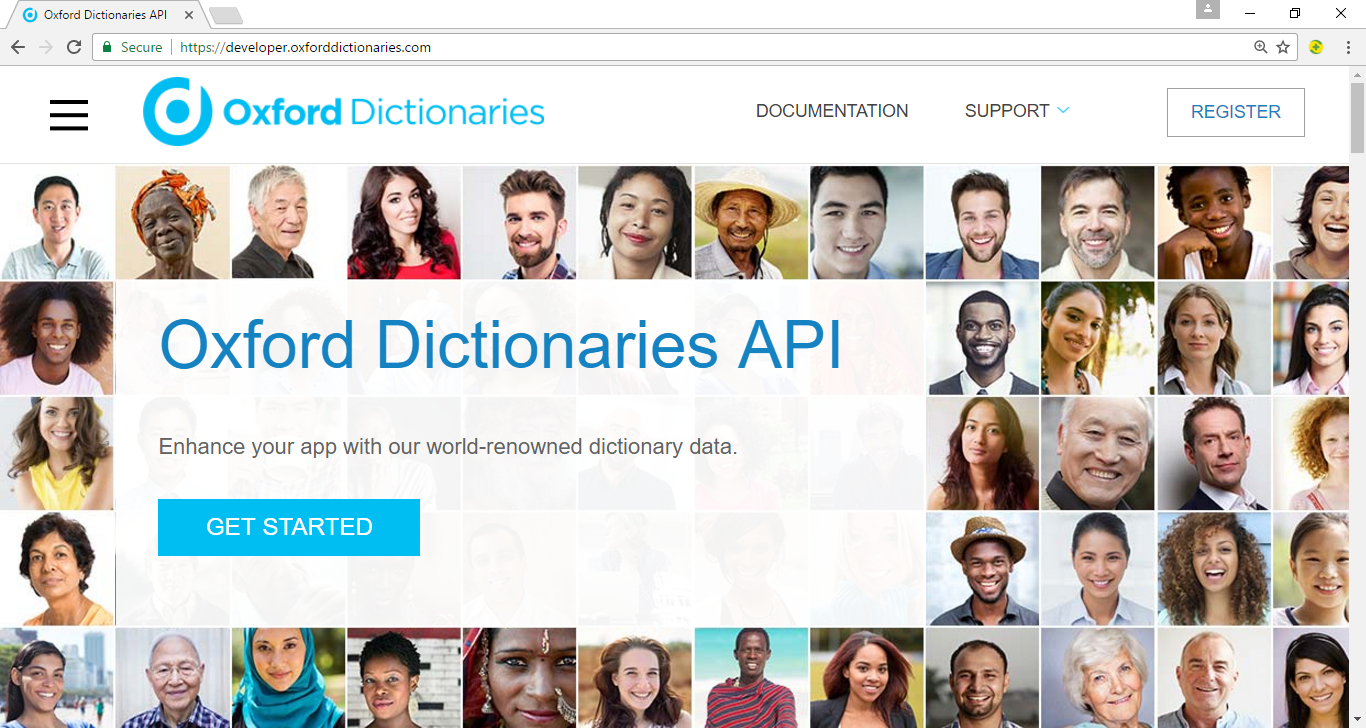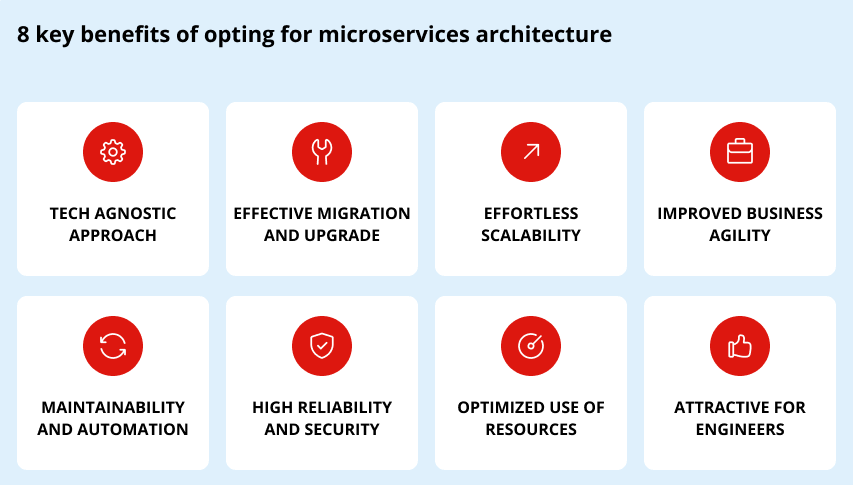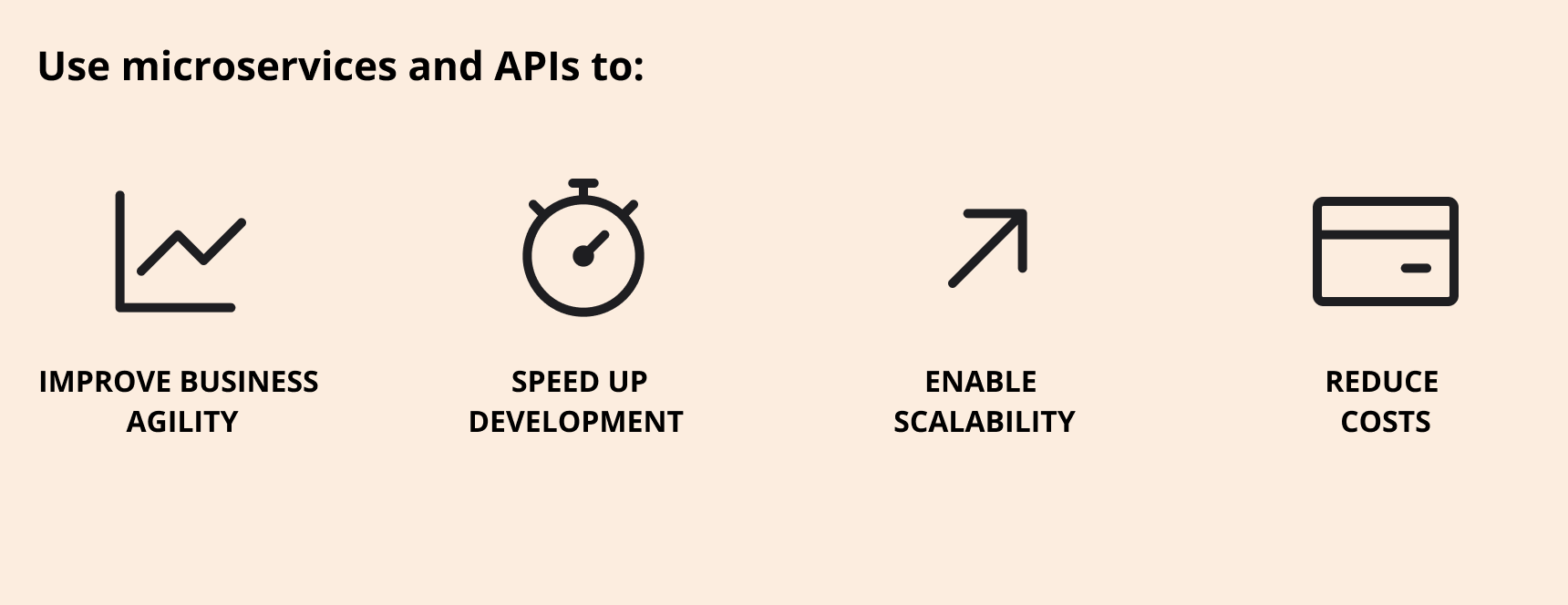API vs. Microservices: Understanding the Difference and Connection
Here’s the first thing you should know about microservices vs. API. They are not opposites. They are not alternatives. They are not even in the same category. They are, however, two tightly related concepts that help engineers create some of the most powerful and successful applications today – Netflix, Amazon, Uber… You get the idea.
So if you work on a modern application, or plan to do so, knowing the difference between API and microservice and ways to leverage each will give you an upper hand. Stay with us, because we are going to tell you how. In the next 5-minute read, you will find answers to the following questions:
- What are APIs and microservices and how are they used for building applications?
- What is the difference between microservices and API?
- How are they connected and when to leverage each?
You are probably familiar with API (Application Programming Interface) as a common term in software development. API is a functional component that helps two or more applications or software modules communicate. To do this, APIs use a set of protocols and tools to interpret and transfer requests, commands, and responses between applications and their components.
Think of it as translator headsets that help people communicate in different languages in real time. Just like human languages, applications may have such differences that make them completely incompatible. And this is when APIs come into play. They enable data transfer and coordinated work between applications, software modules, and services.
There are several types of APIs: private APIs, public APIs, web APIs, database APIs, operating system APIs, and so on. The main distinctions are based on what they link and how. Let’s review only a few common types that will help you better understand the difference between API and microservices we will talk about later in the post.
Public API
Public APIs are open for common use either for free or a fee, depending on the service they connect to. So if you need to integrate with a third-party platform to enrich your application with new functionality or features, you will use the platform’s public API. For example, an Oxford Dictionaries API is a public API that allows developers to enhance their applications with the world’s richest dictionary data.

Oxford Dictionaries API
Private API
Private API is used internally within one system or organization and never exposed to the public. It helps to connect different services in one system and exchange data between business applications within one company. For instance, if your want to create a unified workflow, you will use private APIs to collect scattered experiences and data.
RESTful API
RESTful API or simply REST API plays an important part in API vs. microservices duet. This type of API refers to specific methods and protocols of communication. REST is one of the most popular design approaches for connecting systems over the Internet. It uses standard communication protocols and formats for requests (usually, HTTP) and responses (usually, JSON).
REST APIs create lightweight scalable connections between web systems and components. This makes them a perfect fit for building microservices-based web applications.
Microservices refer to microservices architecture — an effective approach to building modern software out of small loosely-coupled services (microservices), hence the name. Each service is usually responsible for a specific business function (e.g. billing, order management) and has its own business logic, database, and often custom technical specifications.
What is important in the context of this post is how these services are connected. Microservices rely on APIs (that often rely on REST principles, but not only) to connect with client applications, third-party services, and each other. Thanks to APIs, various modules can send and respond to requests and enable smooth data transfer. So in a microservices vs. APIs pair, API acts as an instrument for microservices implementation.
Significant benefits of microservices architecture that include improved business agility, fast time-to-market, and software resilience made microservices the number one choice for creating scalable web applications.

Microservices can be stateless or stateful depending on if and how data is stored during each translation.
Stateless
Stateless microservices don’t need to preserve any state data to process and respond to requests. Every transaction starts from a clean slate, making applications faster and more scalable.
Stateful
Stateful services, on the contrary, rely on the context to work. They store state and/or transaction data in a database and then use it to process requests.
Turn the business advantages of microservices into your competitive edge
Plan, implement and scale your microservices project with an experienced agile team.
Microservices expertiseNow that we have covered this, let’s move on to the difference between microservices and API and review the two concepts side-by-side.
Concept
The single most important difference between API and microservice lies in their nature. API is a medium, a functional component that engineers use to connect software modules, services, and entire applications. Microservices, on the other hand, represent a complete architecture of a system, including all its components and layers, including business logic, API, and data access layer.
Range of use
API has a broader application range compared to microservices. APIs exist outside microservices and are widely used in all types of applications, including serverless apps and monoliths. You can leverage APIs to pull data from a legacy application, integrate with third-party services, or connect scattered experiences and systems used in your company into a unified business application.
Purpose
Another significant difference between microservice and API is the purpose of use. Both microservices architecture and API will help you create a resilient, flexible application. Although the reasons to choose each can be fundamentally different. Microservices is your long-term strategy, while API is often used as a tactic to reach immediate goals.
Solution architects opt for microservices as a design approach to meet major functional and non-functional requirements: enable scalability, reliability, high performance, and so on. In the meantime, engineers often use APIs to solve problems at hand, e.g. reduce development time by connecting to an existing solution via API instead of building one from scratch.
Development costs
It would be a miss to compare microservices vs. API and ignore cost among different parameters. And you may have guessed already that the cost of implementing microservices (read: an entire application) are incomparable to the cost of building an API (read: a component of an application).
But here’s an interesting thing. Microservices and APIs also help reduce development costs, but each in its own way. API often provides immediate savings by allowing you to leverage existing resources, your private databases, or third-party tools instead of building everything from zero. Microservices, on the other hand, provide savings in the long run by bringing agility and speed into the development process.
In many cases, you can skip inventing the wheel and borrow the wheel via API from a third-party provider for a fee or even for free.
We just used 4 fundamental questions (What? Why? How? How much?) to break down the difference and compare microservices with API. Before we move on, grab a quick wrap-up on this comparison in this easy-to-scan API versus microservices table below.
| Compare | Microservices | API |
|---|---|---|
| Concept | Architectural approach that leverages API | Software component (interface) |
| Range of use | Scalable applications | All types of applications |
| Purpose | Create modular applications to enable scalability, reliability, flexibility, and resilience | Enable data transfer between software modules and applications |
| Cost | Medium to high to develop a microservices-based application or migrate to microservices. | Low development cost. Public APIs may be provided for a fee or subscription plan. |
Comparison table: Microservices versus API
As you can see, despite all the differences, these two concepts are closely linked. They have a large overlap in the context of modern software development. This in turn allows us to talk about microservices and API together as a well-tested approach for building powerful business applications fast and cost-effectively.
And this is exactly what we are going to talk about in the next and last part of this guide.

Microservices and APIs are a powerful combo. APIs enable microservices by making it easy to add new functionality and securely connect system parts. At the same time, the growing popularity of microservices makes API a common component of virtually every modern application.
What’s there for you? Endless benefits. You can use both to:
Improve business agility
The Microservices approach brings flexibility to your design and development process. Because it’s always easier to make changes in, cut or expand a particular module than rebuild the whole system. APIs do the same helping you quickly grow or modify your application, add functionality, and even experiment with high-demand technologies like AI by connecting to relevant third-party platforms.
Speed up development
Need to slash time to market? Think about how you could use APIs to leverage databases, applications, third-party services, or other available resources to optimize development time.
Suppose you build a web portal for your wholesale clients and want to add shipping tracking, payment gateway and performance analytics. Instead of building it all from scratch, choose third-party services and connect to them using APIs. There, you just saved yourself months of development work and a ton of money.
Need to set up a rapid development process without jeopardizing quality? Leverage microservices and have small agile teams work on individual functional components in parallel ensuring fast delivery and boutique quality.
Enable scalability
API and microservices help you address even the most rigid scalability requirements (if they are built with scalability in mind, of course). API allows you to quickly expand and add resources as your system grows. The same is relevant for microservices. Each service in microservices can be scaled individually depending on your tech and business needs. Moreover, you can design and build every service with a custom tech stack taking into account its individual elasticity and workload forecast.
Reduce costs
We have mentioned cost reduction before when we talked about the difference between microservices and APIs. It is pretty clear how APIs help you save money – develop less, pay less. It is not so clear with microservices though, but we will try to lay it out for you.
Despite significant upfront costs associated with microservices development services or migration to microservices, this approach provides viable cost optimization for several reasons.
First, high productivity. Smaller highly-focused dev teams work fast, deploy frequently and help you reach your delivery goals while keeping an eye on what’s happening in the market. Secondly, microservices don’t tie you to a specific tech stack, giving you space to quickly migrate to new technologies if, for example, you find cost-optimization opportunities or want to avoid costly tech debt. And finally, reduced risks. Microservices architecture makes very resilient applications where system parts are relatively independent. It means that even if something goes south in one part, the system as a whole won’t collapse causing expensive downtime, lost sales, or any other nightmare scenario you can imagine in this situation.
At this point, you are probably wondering how you could reap all these advantages for your business.
Good news. We can spare you a lot of unnecessary guesswork and develop an actionable plan that aligns with your current and future business needs.
- Guaranteed by a decade of experience in custom software development
- Powered by a strong skill set and mostly (80%) senior specialists on board
- Proven by hundreds of successful deliveries across diverse projects, including custom API development, design and development of API-driven applications, migration to microservices, and end-to-end microservices development.
- Backed by a verified track record and successful projects for our clients in the US, UK, Netherlands, Switzerland, Germany, Spain, and Australia, including:
– Migration to microservices for one of the largest photo labs in the US.
– Development of an API-driven precision medicine solution for a UK data analytics company.
– Development and support of a custom API and developer portal for Oxford Dictionaries (now Oxford Languages).
– Development of a scalable microservices-based SaaS for a travel tech startup based in Spain.
Contact our team to get expert consultation. We will start with a quick discovery call to learn about your current needs and suggest an optimal solution for your business. Or ask us anything on this topic from microservices vs. web API differences to how to analyze API requirements for your system.
Contact Digiteum
Quick round-up
- We answered a popular question “What is the difference between API and microservices?” by going through key identifiers: concept, role, purpose, cost, and business benefits.
- We discovered that API vs. microservices is a powerful duo, where the first often works as a functional component in a microservices-based application.
- We showed how API and microservices are widely used in modern software development to create scalable, reliable applications, optimize time to market, and ensure business agility.








